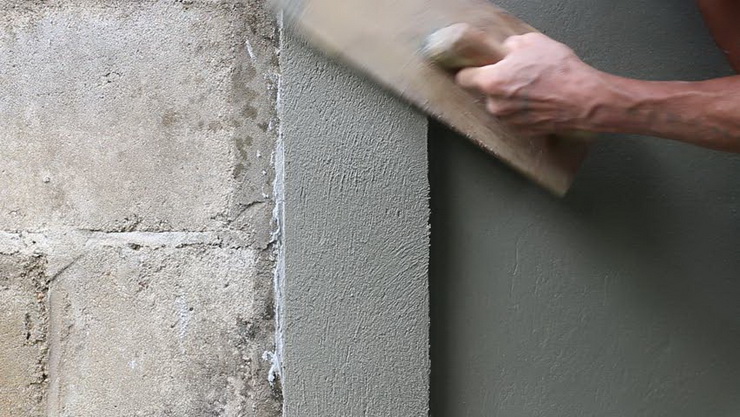Plaster is the most versatile and best material to use when building your interior walls! Many home builders have trusted this material for many generations. Plastering, an ancient technique of building, is used to cover exposed surfaces. It provides decorative effects and protects the surface from atmospheric agents like Vermin or rain penetration.
Different Types Of Plastering Solutions
Take a look at some of the plastering products available on the market.
1. Gypsum plastering.
The mineral gypsum is found in rocks that are rich in calcium sulfate. When gypsum and water are combined, a protective layer is formed on the wall. Gypsum plastering can be used in many different ways to cover masonry surfaces or interior plastering. This is because gypsum-based products are the most cost-effective and safe.
The main characteristics of gypsum plaster is:
- Lightweight
- No need to mix with sand
- No shrinkage cracks
- Perfect rust preventive agent
- Environment-friendly
- Smooth finish
- You can paint directly after primer.
- More malleable, pliable
- Safer for DIY projects
- Non-toxic
- Cost-effective and less wasteful of time, materials, and labor
- It is less susceptible to mold, fungus etc.
2. Cement plastering.
Cement plaster can be used on both exterior and interior surfaces. The cement powder is mixed with water and sand and used to fill in hollow blocks or solid backgrounds. It takes a mason to know the exact amounts of the ingredients required for cement mixing. The final plaster on interior walls with cement composition is gypsum.
The main features of cement plaster include the following:
- Good adhesion strength
- Hardening requires ventilation
- Masonry is a skill that’s required
- Highly resistant to abrasion
- All types of paints can be used with this non-toxic product
- The best paint for finishing and painting projects
- Keep away from fire hazards
- Mix well
- It is susceptible to mold, rust and fungus.
- After the mixture is fixed, it can no longer be used
- Increased load in buildings
- Not environment-friendly
- Longer application process
3. Lime plastering.
A lime plaster is a mixture of sand in the right proportions and volume. This mixture can also be used as an undercoat or a finishing coat. It shrinks when it dries, which is a major drawback. It is known to be a durable material that can restore old and historic buildings. This makes it the best material for masonry repairs.
The main features of lime plaster are:
- Soft and flexible
- The May lasted for a hundred years
- Protect brick and stone
- Water-tight walls
- Adhesive strength is improved
- Let paints and plaster breath
- Protecting walls from moisture improves their stability
The Best And Preferred Plastering Solutions.
There are many different plastering options available. For many reasons, gypsum plastering has been the preferred solution. The importance of gypsum is explained by the following reasons:
1. Reduces construction time
The cement plaster requires a waiting period of 21 days to allow the plaster to settle and harden. The cement plaster must be sprayed and left to dry for 21 days. Wait 21 days before you begin any work above or on the wall.
You don’t have to wait as long with gypsum. The gypsum plaster dries in three days and settles, so construction can move more quickly. If you’re building a multi-story structure, the construction time can be reduced by multiples.
2. Eliminates shrinkage cracks
Other plasters may have some shrinkage-related cracks after they are completely dried. Before painting, Plaster Of Paris is applied to the cement-plastered wall in order to achieve a smooth surface. The chance of shrinkage cracks is eliminated with gypsum as it settles automatically to a surface that is smooth enough to paint.
3. Less impact on the environment
Other plasters, such as cement plaster, require river sand. This is not an eco-friendly way to build. Gypsum can be found in thick and wide beds along with sedimentary rocks. It is naturally deposited by sea and lake waters. Gypsum is susceptible to depletion as it is constantly deposited by sea and lake waters. It can be produced artificially. It is also not harmful to your health.
4. Low water use
Some plasters require a longer wait period, such as cement plaster. It requires a large amount of water to be poured on the walls coated with it to wet them completely. The need to use water for gypsum is not necessary, which saves a lot of water and the time of pouring it. We are still developing water-saving techniques in our country, which puts us in the best position to conserve water. Gypsum plaster is a good choice because it uses less water.
5. Easy application
Other plastering methods, such as cement plastering, require many steps. From sieving the sand and removing any large stones to mixing with water to get the desired consistency. Gypsum is easy to clean, as it does not require many procedures. This is unlike the mixtures of sand cement, which are difficult to remove. When combined with aluminum frames, gypsum can be easily modified to create textures, designs, and shapes.
6. Lighter construction
The use of false ceilings and cantilever designs is made stronger by the lighter weight of gypsum plaster. The frames will be more durable and robust if they are lighter. They also offer better protection against natural disasters like earthquakes. Gypsum has a high water content, which makes it non-combustible.
The best plastering option among the various plastering options is gypsum. For more info – https://aucklandpremiumpainters.co.nz/plastering/
